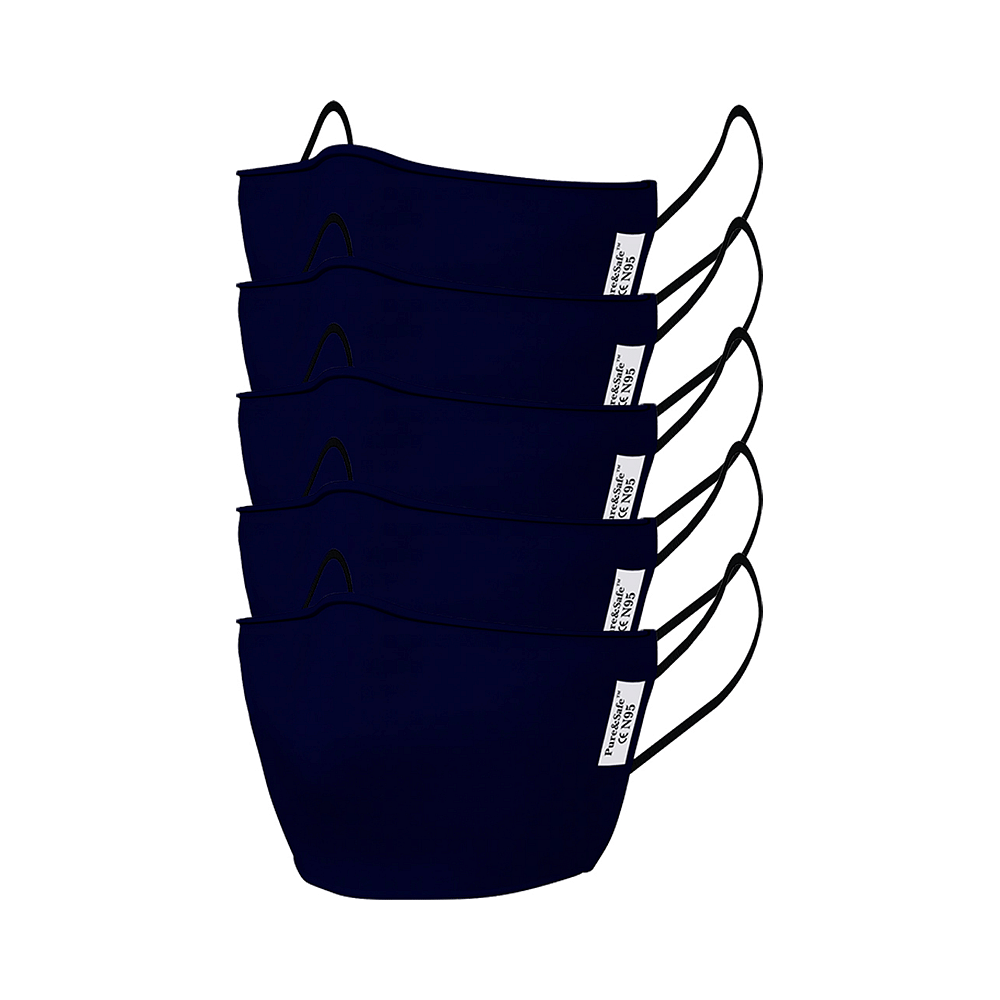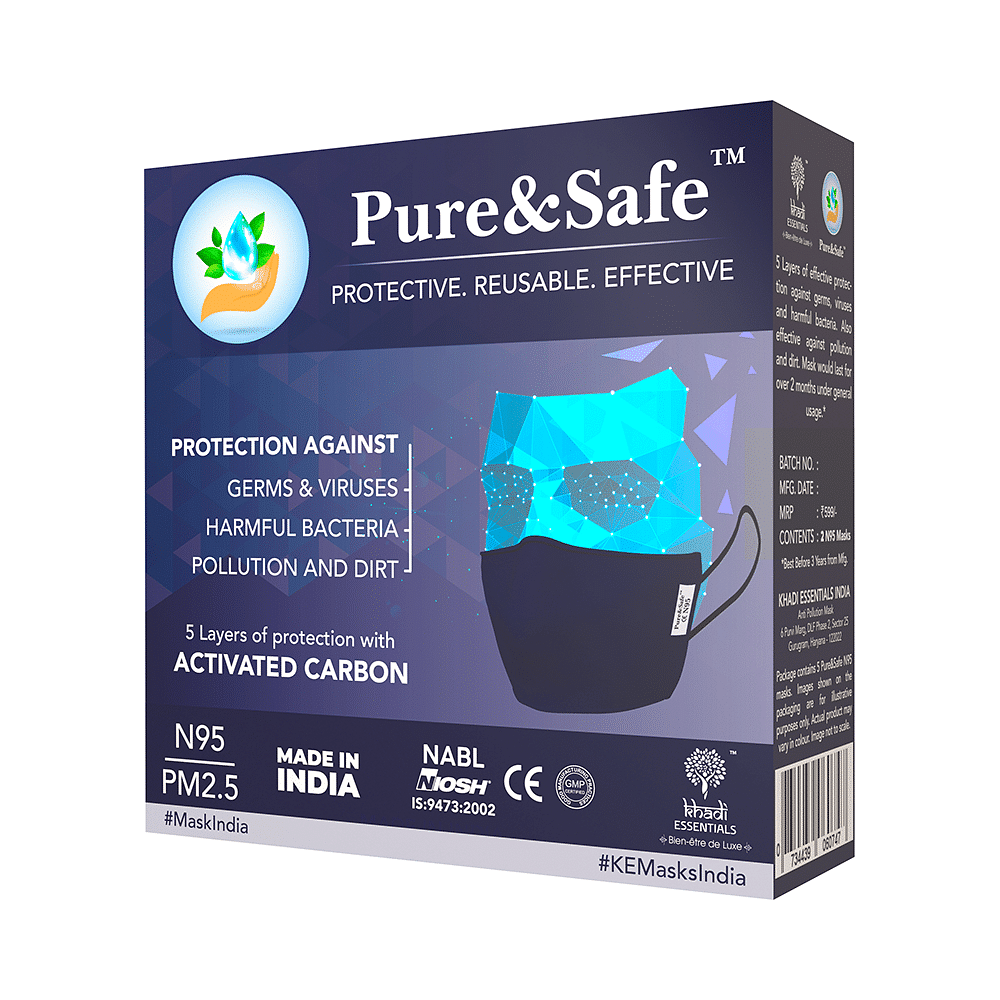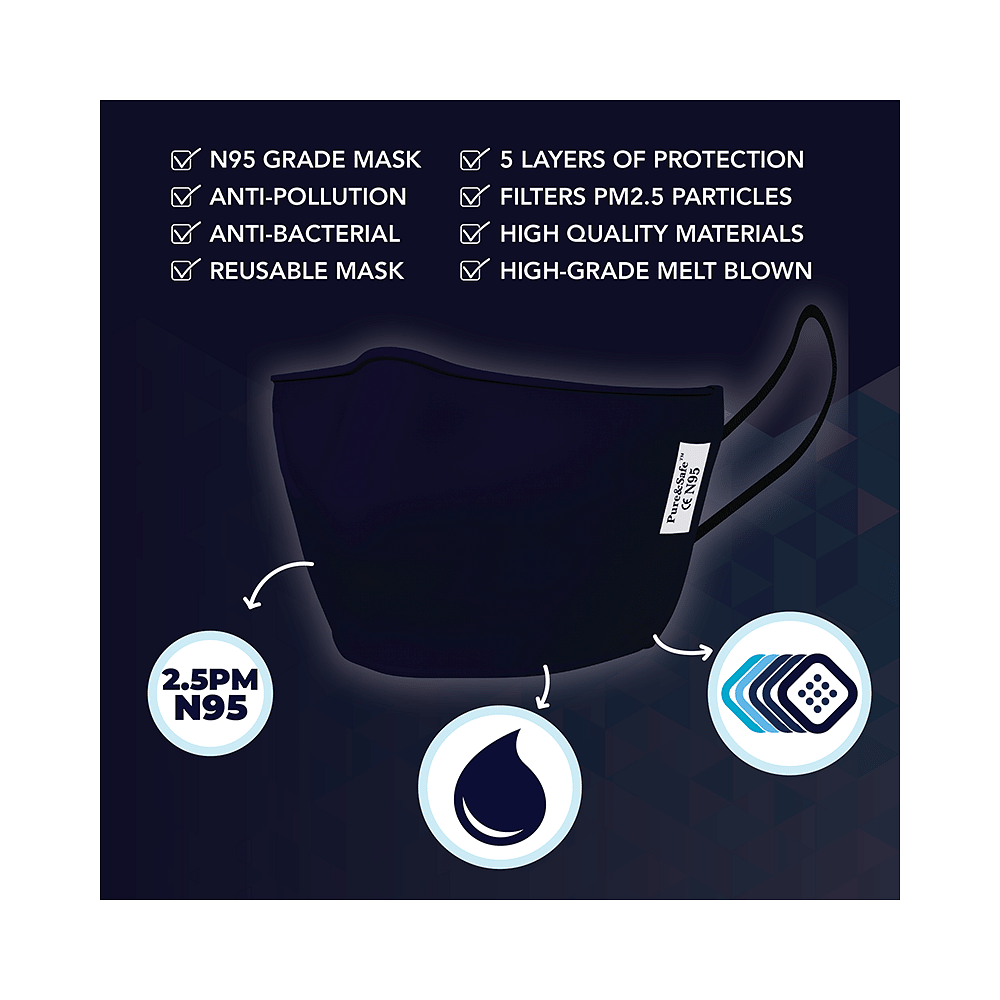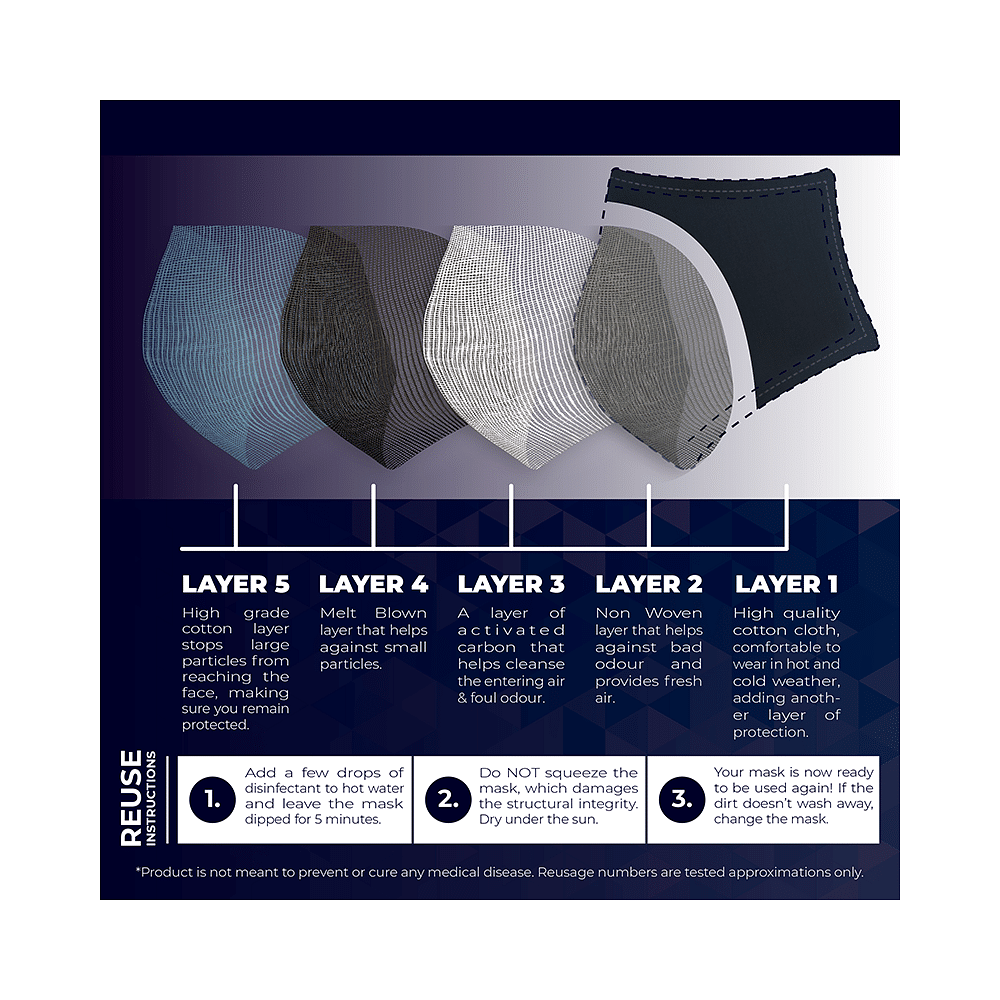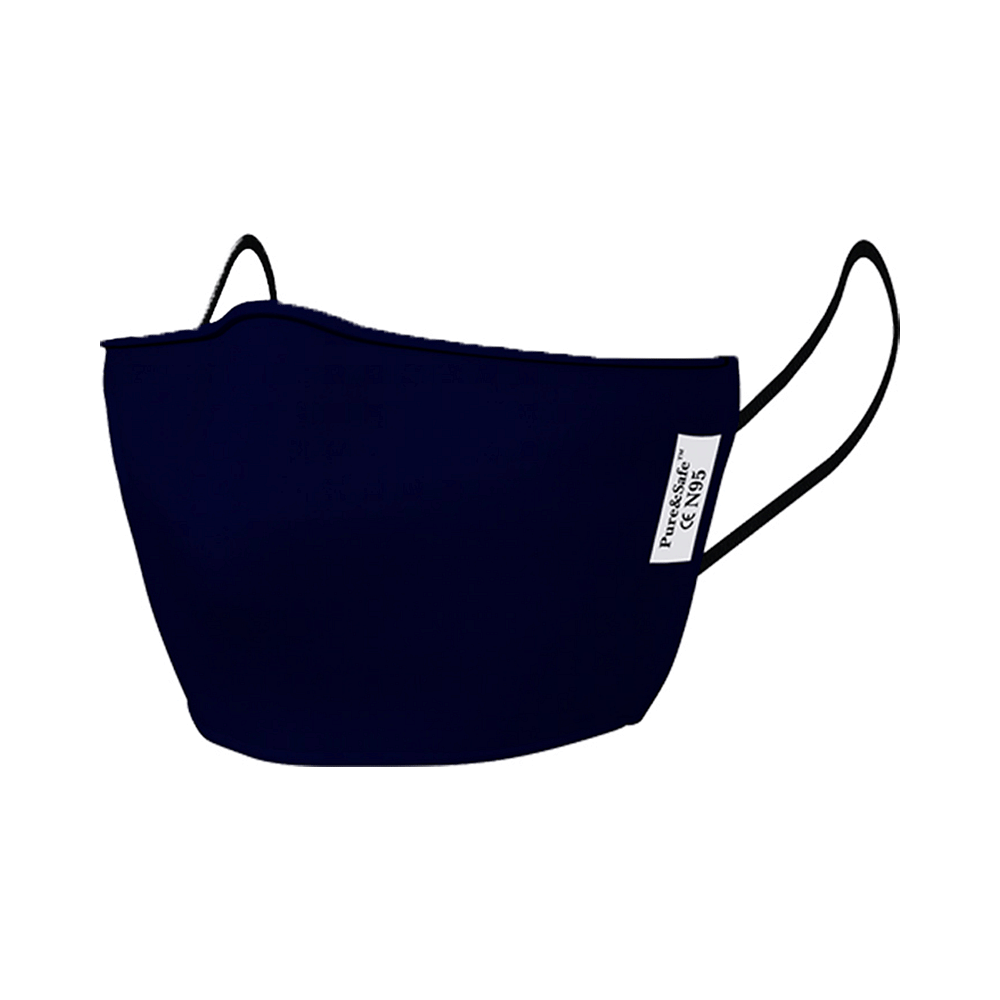Pure & Safe N95 PM2.5 Mask
5 masks
Manufacturer
The House of Khadi Essentials
Pure & Safe N95 PM2.5 Mask is a reusable mask that filters out harmful pollutants and microbes, helping you to breathe fresh air. It is ideal for outdoor usage, especially in polluted cities, and offers protection against various microbes and airborne biological particles.
Introduction:
The Pure & Safe N95 PM2.5 Mask is a disposable particulate respirator designed to provide reliable respiratory protection of at least 95% filtration efficiency against certain non-oil-based particles. It is highly recommended for people with a higher risk of contracting respiratory diseases, living in or traveling to areas with high air pollution levels. The mask filters air pollutants, pollens, smoke, odors, diesel, gasoline, pathogens like bacteria, viruses, and fungi, and helps in filtering smoke, both natural and artificial.
Dosage Form:
Mask
How to Use:
Pre-stretch the straps before placing the respirator on the face and position the respirator over the nose and mouth. Pull the top strap over the head, position it at the top back of the head and above the ears. Pull the bottom strap over the head and position it around the neck below the ears. Press the nose piece with your fingertips to mold it to the shape of the nose to seal air off effectively. Check the respirator-to-face seal for each wearing.
How it Works:
The N95 respirator is designed to filter out at least 95% of very small (0.3 microns) particles or PM2.5 particulate matter, which tends to stay longer in the air and is thus more likely to be inhaled.
Quick Tips:
FAQs:
Introduction:
The Pure & Safe N95 PM2.5 Mask is a disposable particulate respirator designed to provide reliable respiratory protection of at least 95% filtration efficiency against certain non-oil-based particles. It is highly recommended for people with a higher risk of contracting respiratory diseases, living in or traveling to areas with high air pollution levels. The mask filters air pollutants, pollens, smoke, odors, diesel, gasoline, pathogens like bacteria, viruses, and fungi, and helps in filtering smoke, both natural and artificial.
Dosage Form:
Mask
How to Use:
Pre-stretch the straps before placing the respirator on the face and position the respirator over the nose and mouth. Pull the top strap over the head, position it at the top back of the head and above the ears. Pull the bottom strap over the head and position it around the neck below the ears. Press the nose piece with your fingertips to mold it to the shape of the nose to seal air off effectively. Check the respirator-to-face seal for each wearing.
How it Works:
The N95 respirator is designed to filter out at least 95% of very small (0.3 microns) particles or PM2.5 particulate matter, which tends to stay longer in the air and is thus more likely to be inhaled.
Quick Tips:
- Please follow the usage instructions & precautions as recommended to ensure proper use of the face mask. Improper usage of the mask may cause health risks.
- Do not share the mask with your friends, family members, or relatives as it can increase the risk of contamination, which in turn can harm you or your loved ones’ health.
- Remember, the mask is for individual use ONLY.
- Maintain the hygiene of the face and hands.
- Personal health conditions should be kept in mind.
- Check and make sure that the respirator is intact and not damaged. Check the expiry date and if the mask is packed properly.
- Before use, the wearer must read and understand the user instructions provided on the product packaging.
FAQs:
- What is an N95 respirator?
N95 Mask is a disposable particulate respirator that is designed to help provide reliable respiratory protection of at least 95% filtration efficiency against certain non-oil-based particles. - Do N95 respirators provide protection against infection?
Yes, this NIOSH (National Institute for Occupational Safety and Health) approved N95 respirator can help reduce inhalation exposures to certain airborne biological particles (examples: mold, Bacillus anthracis, Mycobacterium tuberculosis). - What is the correct method of wearing a N95 respirator?
Pre-stretch the straps before placing the respirator on the face and position the respirator over the nose and mouth. Pull the top strap over the head, position it at the top back of the head and above the ears. Pull the bottom strap over the head and position it around the neck below the ears. Press the nose piece and mold it to the shape of the nose to seal air off effectively. Check the respirator-to-face seal for each wearing. - What precautions should one take before wearing an N95 respirator?
Some of the common precautions are to maintain the hygiene of the face and hands. Keep in mind the personal health conditions. Check and make sure that the respirator is intact and not damaged. Check the expiry date and whether the mask is packed correctly. Before use, make sure to read and understand the user instructions provided on the product packaging. - Is everyone suitable to wear the N95 respirator?
If you are suffering from any respiratory disease like asthma or emphysema, etc., then you must seek medical advice before wearing it. In case you experience any discomfort, breathing difficulties, dizziness, etc. after wearing the respirator, avoid wearing it. Do not wear a respirator if you are pregnant. - Can N95 respirator be used by children as well?
No, as its size may not be applicable to children’s faces and will affect their effectiveness. Therefore not suggested for children to use the mask. - What guidelines should be followed in storing the N95 respirator?
Avoid its storage in hot and humid places. The place and containers for storage should be neat and clean. Note down the purchase date and keep the receipt. - Is there any fixed duration of time to wear the respirator?
No, it depends on different environmental situations. However, if breathing difficulty or any distress occurs, the wearer should immediately leave the hazardous area (such as the ward or the place with polluted air) and then take the respirator off. - When should you change to a new respirator?
Respirators need to be changed if the respirator is contaminated by body fluids like blood or spittle or if the respirator is damaged.
